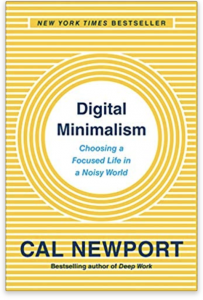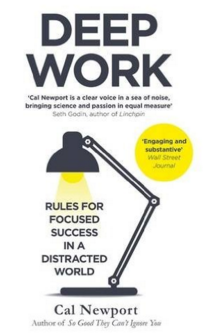I recently read “Slow Productivity: The Lost Art of Accomplishment Without Burnout” by Cal Newport. Below are the quotes I found most interesting. If you like them, buy the book here.
“The details of CBS’s turnaround provide a useful contrast berween / differing conceptions of productivity. Moonves tried to save his network by pushing his employees to work more. What ended up mattering, however, was instead the obsessive efforts of an eccentric creative talent who spent over three years nurturing a vision, coming at it again and again in an attempt to create something special… It should be noted, of course, that the eventual realization of Zuiker’s creative efforts also required the bold support of CBS executive Nina Tassler. This massive contribution from Tassler had little to do with working late or demonstrating busyness. It was instead much more about the application of creative instincts forged through long experience. These are the types of actions that ultimately make the difference in breakout success, not dramatic demonstrations of work ethic.” (28-29)
“Slow Productivity is a philosophy for organizing knowledge work efforts in a sustainable and meaningful manner, based on the following three principles:
- Do fewer things.
- Work at a natural pace.
- Obsess over quality.” (41)
“Strive to reduce your obligations to the point where you can easily imagine accomplishing them with time to spare. Leverage this reduced load to more fully embrace and advance the small number of projects that matter most.” (53)
“When you agree to a new commitment, it brings a certain amount of ongoing administrative overhead: back-and-forth email threads needed to gather information, for example, or meetings scheduled to synchronize with your collaborators. This overhead tax activates as soon as you take on a new responsibility. As your to-do list grows, so does the total amount of overhead tax you’re paying. Because the number of hours in the day is fixed, these administrative chores will take more and more time away from your core work, slowing down the rate at which these objectives are accomplished. At moderate workloads, this effect might be frustrating: a general sense that completing your work is taking longer than it should. As your workload increases, however, the overhead tax you’re paying will eventually pass a tipping point, beyond which logistical efforts will devour so much of your schedule that you cannot complete old tasks fast enough to keep up with the new.” (56)
“Most workers who are fortunate enough to exert some control over their efforts-such as knowledge workers, small-business entrepreneurs, or freelancers-tend to avoid taking on so much work that they crash and burn, but also tend to avoid working a reasonable amount. They exist at that point of maximum sustainable overhead tax that seems to represent the worst of all configurations, as it maintains the pain of having too much to do, but keeps this pain just manageable enough to avoid reform.” (61)
“There’s a calibrated steadiness to working on just one major initiative a day. Real progress accrues, while anxiety is subdued.” (76)
“taming the impact of small details in your professional life opens up space to pursue bigger goals.” (80)
“Small tasks, in sufficient quantity, can act like productivity termites, destabilizing the whole foundation of what you’re trying to build. It’s worth going to great lengths to tame them.” (82)
“The general goal for this proposition is to help you avoid working at a constant state of anxious high energy, with little change, throughout the entire year. Summering at Lake George can disrupt this unnatural rhythm, but so can taking off a random weekday once or twice a month. I call these latter, more modest efforts small seasonality.” (147)
“Don’t schedule appointments on Mondays.” (147)
“There’s something about entering a movie theater on a weekday afternoon that resets your mind. The context is so novel – “most people are at work right now!” – that it shakes you loose form your standard state of anxious reactivity.” (148)
“As your calendar continues to fill during busy periods, a sense of mild despair can arise. How will I ever get this all done? A clever way to balance this stress is to pair each major work project with a corresponding rest project. The idea is simple: after putting aside time on your calendar for a major work project, schedule in the days or weeks immediately following it time to pursue something leisurely and unrelated to your work.” (149)
“The key is to obtain a proportional balance. Hard leads to fun. The more hardness you face, the more fun you will enjoy soon after.” (149)
“When seeking out where you work, be wary of the overly familiar.” (160)
“Obsess over the quality of what you produce, even if this means missing opportunities in the short term. Leverage the value of these results to gain more and more freedom in your efforts over the long term.” (173)
“Doing fewer things and working at a natural pace are both absolutely necessary components of this philosophy, but if those earlier principles are implemented on their own, without an accompanying obsession with quality, they might serve only to fray your relationship to work over time— casting your professional efforts as an imposition that you must tame.” (174)
“A little quality work every day will produce more and more satisfying results than frantic work piled on top of frantic work.” (177)
“Obsession requires you to get lost in your head, convinced that you can do just a little bit better given some more time. Greatness requires the ability to subsequently pull yourself out of your self-critical reverie before it’s too late.” (198)
“Give yourself enough time to produce something great, but not unlimited time. Focus on creating something good enough to catch the attention of those whose taste you care about, but relieve yourself of the need to forge a masterpiece. Progress is what matters. Not perfection.” (199)
“As Ballard later recalled about working with Morissette:
She just wanted to be an artist. She didn’t want the system to tell her they “didn’t need her anymore.” She just wanted to say what she felt…. She just wanted to write songs and express herself.” (200)
“These authors demonstrate one of the more approachable strategies for betting on yourself: temporarily dedicating significant amounts of free time to the project in question.” (204)
“It’s in these details that we find a balanced strategy. Don’t haphazardly quit your job to pursue a more meaningful project. Wait instead to make a major change until you have concrete evidence that your new interest satisfies the following two properties: first, people are willing to give you money for it, and second, you can replicate the result.” (207)
“But the fancy cameras alone don’t explain the movie’s success. The pressure and drive to satisfy Akkad, who had invested serious money in the project, helped push Carpenter’s craftsmanship to new levels. His goal with Assault was to showcase his talents. His goal with Halloween was to create a classic movie. This is an important difference.” (210)
“When someone has invested in your project, you’ll experience amplified motivation to pay back their trust.” (210)
“Attracting other people to invest in you and your idea is a dramatic bet on yourself and your ability to not let others down. In the drive to avoid this disappointment, greatness can be found.” (211)
“McPhee would photocopy these pages, and then use a pair of scissors to cut out each self-contained chunk of notes into its own “sliver” of paper. (When McPhee eventually bought a personal computer in the 1980s and began using an electronic system to organize his notes, he referred to the machine as a “five-thousand-dollar pair of scissors.”)” (214)
“Productivity at the large scale doesn’t require frantic busyness at the small.” (217)
“John McPhee marveled at the idea that anyone might think of him as being unusually hardworking: And if somebody says to me, “You’re a prolific writer”—it seems so odd. It’s like the difference between geological time and human time. On a certain scale, it does look like I do a lot. But that’s my day, all day long, sitting there wondering when I’m going to be able to get started. And the routine of doing this six days a week puts a little drop in a bucket each day, and that’s the key. Because if you put a drop in a bucket every day, after three hundred and sixty-five days, the bucket’s going to have some water in it.” (218-219)
“Slow productivity, more than anything else, is a plea to step back from the frenzied activity of the daily grind. It’s not that these efforts are arbitrary: our anxious days include tasks and appointments that really do need to get done. But once you realize, as McPhee did, that this exhausted scrambling is often orthogonal to the activities that matter, your perspective changes. A slower approach to work is not only feasible, but is likely superior to the ad hoc pseudo-productivity that dictates the professional lives of so many today.” (219)
Liked the quotes? Buy the book here.




